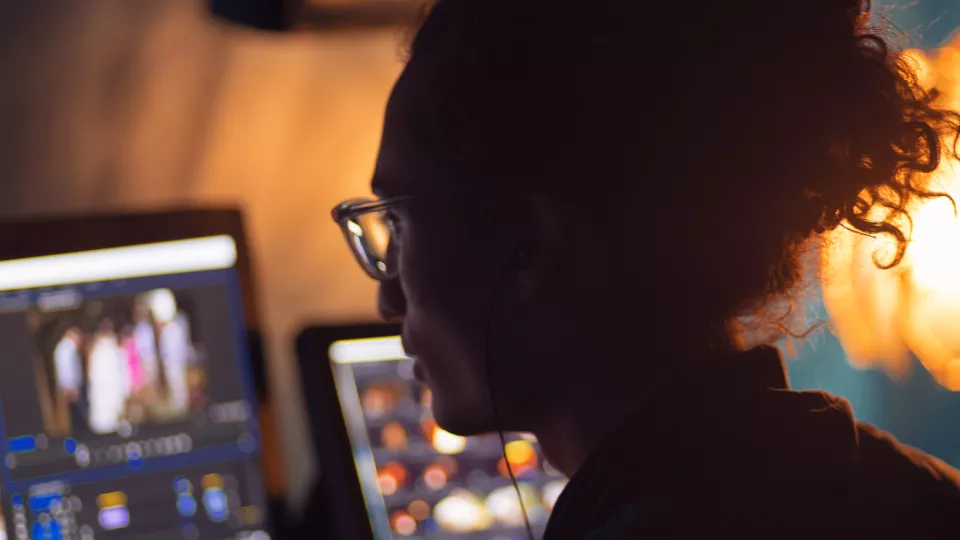Photo: Nicole Geri on Unsplash.com.
This situation with teaching taking place both on campus and online, often called "blended learning", is perhaps better described as the extended classroom. Now that we are seeing changes in our teaching, it is important that we use our common pedagogical experience and keep the focus on our courses’ intended learning outcomes. This article provides a brief overview of research in this area from the past year, drawn from different countries and disciplines.
The practical conclusions drawn by the authors are as follows:
- Video lectures should be divided into shorter sections, and they become more effective and concise if you use a script.
- Video lectures with "talking head" (where you see the lecturer) or where you write on a whiteboard, are as effective as an in-class lecture and more effective and engaging than other types of video lectures (such as a power point with audio).
- The fact that the teacher appears on the screen in lectures, announcements, feedback, etc. creates so-called social presence.
- It is unclear how well produced a film needs to be to keep students interested and engaged, and it may therefore be unnecessary to invest in the technology and education required to produce high-quality films.
- If video is more widely used in teaching, students will become more accustomed to the use of video and then, for example, examination through video submissions can help students not only to learn the course content, but also to learn technology that is important for the working life.
Different ways to use video in teaching
Pre-recorded video that students can watch when it suits them (so-called asynchronous video)
The advantages of this type of video are that students can pause, increase speed and watch several times, which has been shown to improve learning. However, it is easy for students to postpone viewing when they can watch the video whenever they want.
The literature is not clear about the optimal length of a recorded video, but perhaps that a shorter film (under 10 minutes) is better than a longer one. Interactivity, such as a quiz, in a pre-recorded video can increase student engagement and learning, but too much interactivity can be distracting and impair learning.
Live video with a video conferencing tool (so-called synchronous video)
In a synchronous video, it can be easier to create interaction and a sense of context, and it is possible to reach students who are in different geographical locations (advantage over classroom teaching). However, technical problems often arise (poor internet connection, for example) and in purely online courses it can be difficult to have scheduled activities if students are in different time zones or for other reasons need flexibility in terms of when they can spend time on studies.
Video to create discussion outside the classroom (so-called asynchronous discussion)
To get discussions started on, for example, a discussion forum, a video can help, and the literature provides examples of different kinds of video for this purpose. A slightly more informal video (e.g. created with a mobile camera) can create a welcoming atmosphere for discussion, however, a more formally recorded video seems to provide more viewings, more discussion and more learning. Using third-party videos (from the publisher, from Youtube etc) is also a possibility. This type of video is often of better quality than the individual teacher can achieve, but it can also create a distance to the teacher.
Discussions using a video conferencing tool (so-called synchronous video-based discussions)
Video conferencing tools enable discussions between students in classrooms in different geographical locations (for example, a classroom in Lund with a classroom in Stockholm). This is usually fun, but some technical problems often arise, and it may not improve learning.
In hybrid teaching, when some students are in the lecture hall and others are online, studies show that it is beneficial for online students to participate in the discussions in the lecture hall, but that for the students in the lecture hall it is more distracting. Also, there are often some technical difficulties involved.
Video for self-reflection and assessment
In subjects such as language and drama where certain skills need to be demonstrated in other ways than through a written text, students can record themselves. This can be used for the student to reflect on their performance, for peer reviewing or for assessment by the teacher.
Another way for students to reflect on their learning is through video blogs. Studies show that students have appreciated this form of blog where they also have been allowed to practice their oral presentation skills (articulation, posture, expression) but that the time needed to learn the technique can take time from learning the material.
Allowing students to make a video (e.g. a recorded presentation) as part of the examination instead of having them submit a written paper is also an opportunity that has been shown to lead to higher engagement and collaboration skills among the students. But again, technical difficulties can create obstacles to learning the content meanwhile what students learn about recording videos can be beneficial for the future even if this itself is not assessed.
Video "check-in"
In pure online teaching, the teacher can create relationships with the students by recording videos where he/she presents himself/herself (at the introduction of the course) or where he/she tells the students what happens the coming week. Virtual office hours are another way for the teacher to be present on the course and create relationships with students.
References
Belt, Eric S., and Patrick R. Lowenthal. 2021. Video Use in Online and Blended Courses: A Qualitative Synthesis, Distance Education, Distance Education 42 (3): 410-440.
Link to full text here.
More to read about video in teaching
Introduction to Studio (Canvas video tool).
In the help guide for Studio in Canvas, you can learn more about how you can use video in your teaching as well as things to consider when recording. There are also links to other articles about video in teaching. In addition, there are clear guides on how to practically record videos in Studio in Canvas.
Go to the guide Studio in Canvas.
Article on the use of quizzes in video.
A teacher writes about how he uses asynchronous video in his teaching (in Swedish).



